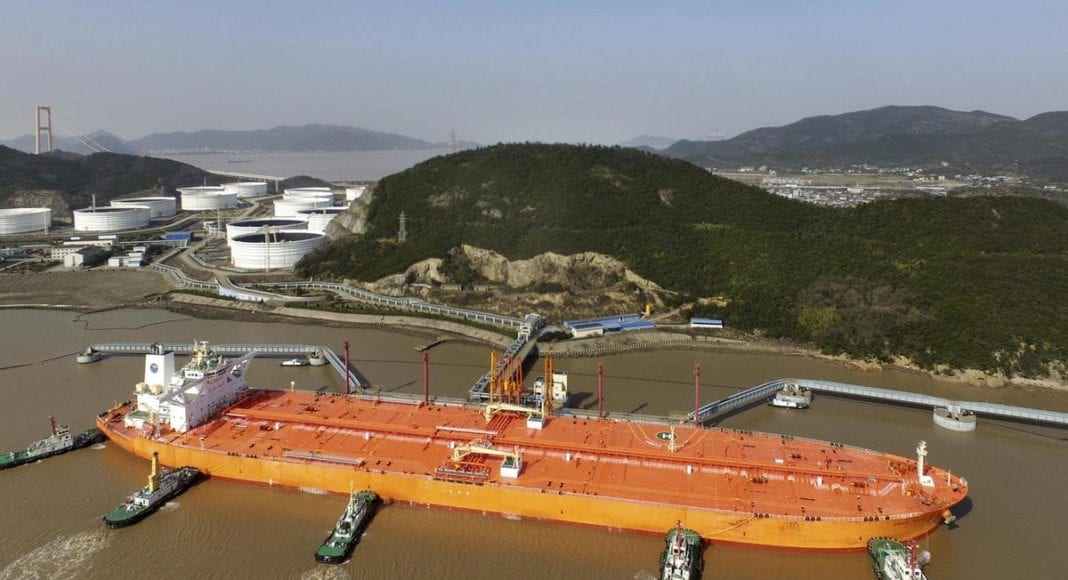China’s crude oil stockpiles will likely extend the uptrend to hit a new record high in June as refinery feedstock imports outpace the rise in throughput levels, while storage availability encourages refiners to actively procure barrels to take advantage of low crude prices, S&P Global Platts said in a report on Monday.
The slide in crude prices and recovery in economic activity late March had encouraged Chinese buyers to pile their shopping carts with all kinds of cheap crude, which were scheduled for delivery from late May through June.
As a result, trade flow and inventory tracker Kpler forecast on June 22 that China’s seaborne crude arrivals will hit 14.16 million b/d in June, a new record high following 10.21 million b/d in May even though some of the June arrivals are more likely to be discharged in July due to port congestion.
The country last month imported 11.34 million b/d of crude — a historical high, General Administration of Customs data showed. China imports crude through both shipping and pipelines.
Reuters reported in April that Chinese independent refiners snapped up rare crude grades from the North Sea and Guyana at low prices after the coronavirus pandemic destroyed demand. The North Sea grades bought included Balder, Flotta and Chestnut crude, while Guyana’s Liza crude was sold into China for the first time, the sources had told Reuters.
Combined with stable domestic crude output at around 3.9 million b/d over the first-half of 2020, China’s crude supplies are set to be over 14.3 million b/d in June, S&P Global Platts estimates.
STATE-OWNED REFINERS BOOST JUNE THROUGHPUT
Crude throughput in June is also set to see a month-on-month increase with state-owned refiners Sinopec, PetroChina, CNOOC and Sinochem ramping up run rates to average 80% of capacity from 76% in May, as profit margins strengthen, a Platts survey showed.
China’s crude throughput in June is more likely to be around 13.8 million-14 million b/d as the state-owned refiners’ average run rate is slightly lower than 83% recorded in December, when the country’s crude throughput was at a record high of 13.84 million b/d, Platts estimates. The state-owned refiners account for about 65% of China’s total capacity.
Meanwhile, Sinopec’s greenfield 200,000 b/d Zhongke Petrochemical will not contribute notable throughput until July, although it officially came on stream on June 16, industry sources said.
Kpler’s data showed that China’s crude inventory hit 842 million barrels in the week starting June 15 — a record high since January 2017, when Kpler began to provide the data.
The rise in inventories started from the week of May 11, when the stock level reached a bottom of 797 million barrels after it hit a peak of 808 million barrels in the week of April 13.
PORT CAPACITY DOES MATTER, NOT STORAGE SPACE
As cheap crudes intensively arrive during June, the barrier to rising stocks emerged from port capacity rather than storage capacity, port sources and analysts said.
In Shandong’s Qingdao port area — China’s busiest crude handling port by turnover — there were almost 40 crude-laden vessels waiting for discharge as of June 22, a source with the port said, adding that normally there would be a queue with only around 10 crude carriers.
“It is impossible to discharge all these cargoes until July,” the port source said.
As a result of the bottleneck, about 18 cargoes totaling 23.9 million barrels of crude have been floating around the Qingdao port area for more than a week, Kpler data showed on June 22.
On the contrary, China still has around 330 million barrels of crude storage capacity available, including all capacity from underground SPR storage caverns to tanks in the refining system, Kpler said.
The largest individual locations with capacity yet to be filled are two underground SPR caverns — 31.6 million barrels in Zhanjiang and 31 million barrels in Huizhou, Kpler said in the report.
“Huizhou is operational but has not yet received any cargoes, as the situation surrounding Zhanjiang [data] is uncertain,” Kpler added.
In addition, China is set to expand its commercial crude storage capacity by at least 15.11 million cu m, or 95.04 million barrels, by the end of 2020, Platts reported on June 10. Among these new tanks, 74.85 million barrels of capacity is expected to come on stream in the second-half of the year, S&P Global Platts said.




